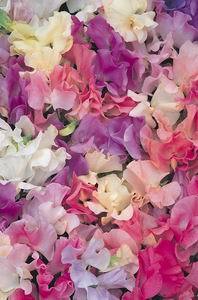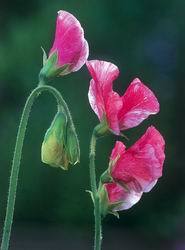Sweet peas – English gardeners have always understood their appeal, calling them the queen of annuals. Their fragrance is an lovely mix of honey and orange blossom – and their ruffled flowers look like colorful butterflies.
The flowers come in many colors – red, blue, lavender and pink and white. Depending on the cultivar, they can be solid colors, bicolors or streaked.
Try different types of sweet peas

National Gardening Bureau Photo
Sweet peas are perfect in the flower garden, cutting garden and casual cottage garden, or simply grown up a trellis or fence.
Most cultivars are climbers, but you can get dwarf bush types for annual plantings or containers.
You can enjoy sweet peas from early spring onward. If you live in the southern states, sow them by seed in the fall.
In northern regions and through most of Canada, plant them in the cool weather of early spring.
Sweet peas make long-lasting cut flowers: for a fragrant bouquet, arrange a dozen stems in a simple vase.
Direct seeding into the garden
Sweet peas are an easy annual from seed because you can direct seed them into the garden.
They grow best in full to partial sun and in deep, rich, loamy, moist, but well-drained soil, and should be sown or planted out during cooler seasons.
Before sowing seeds, add plenty of organic matter (compost, well-rotted manure, leaf mold, or humus) to enrich the soil and make it easier to work.
In the warmer parts of western North America, you can sow the seeds from August on to maximize winter and spring flowering. Although the plants can be killed back by hard freezes, they are quite cold hardy and can take frost without much damage to plants.
In the US south, you can sow seed in November or December for early spring flowers.
However, in the drier and colder mid-west and the colder parts of Canada, it’s best to start seeds early indoors and then transplant then into the garden, or sow them directly into the garden early in spring – up to six weeks before the last frost date.
How to start sweet pea seeds indoors

National Gardening Bureau Photo
For a head start – especially in cold-winter areas where cool spring weather quickly turns into the heat of summer – sow seeds indoors six to eight weeks before the last frost date.
The seeds have a hard seed coat, but you can speed and increase germination by nicking the outside seed coating carefully with a nail clipper.
Sow seeds into peat pots or four-inch plastic pots filled with a soil less seed-starting mix. Use two or three seeds per pot and push each an inch down into the potting mix. Cover with mix, water, and put pots in a cool, dark place.
After about 10 days, keep an eye out for new shoots emerging above the soil. At that point, set seedlings into bright light. Keep them in a cool place below 55°F (12ºC). If they are coddled in a warm room, they won’t be tough enough to transplant outdoors without a lengthy hardening off period.
When seedlings have two sets of true leaves, thin to one plant per pot.
Garden growing tips
Plant seeds in holes that are about two inches deep. Space holes about four to six inches apart and sow two to four seeds per hole. Water thoroughly and keep soil moist until seeds have sprouted. You should see germination in about 10 to 21 days.
Once the seedlings are growing, water regularly to promote good growth. When the seedlings are three to four inches high, thin them out, and leave the most vigorous-looking plants growing four to six inches apart.
Once you have thinned, mulch around the plants with a four- to six-inch layer of organic mulch to keep the roots cool and the soil moist.
Supports for your plants
When you plant taller vine-type cultivars, place the stake or support into the ground at the same time as the seed or transplants to avoid damaging the roots.
A trellis is the most common support, or you can try bird netting strung between two stakes, string, twine, or fishing line hung from the top of a split rail fence. Bamboo teepees and brush stakes also make good supports.





